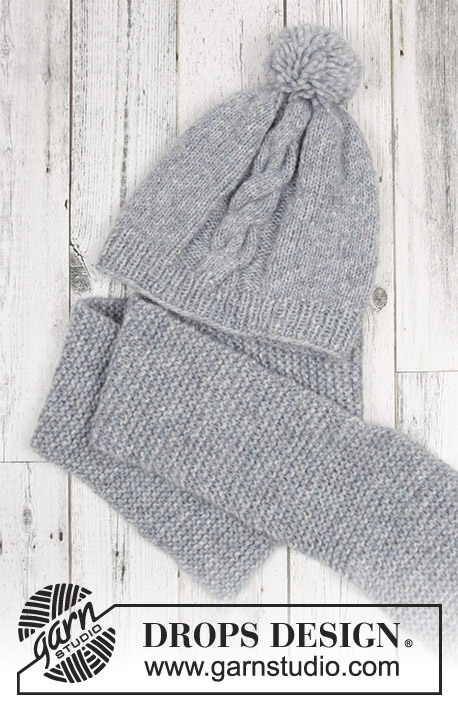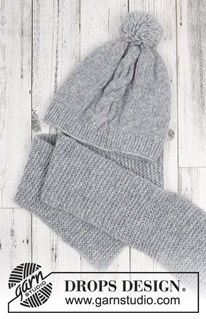Comments / Questions (12)
![]() Maryse Rosière wrote:
Maryse Rosière wrote:
Bonjour. Je ne comprends pas Votre décompte au moment des diminutions. 87 m moins 23. Reste 64. Avec 4 fils marqueurs. Cela Ne fait pas 12 entre les fils. Merci de m’éclairer.
13.10.2024 - 15:14DROPS Design answered:
Bonjour Mme Rosière, vos marqueurs doivent être placés ainsi: 22 m, 1 marqueur, puis (12 m, 1 marqueur)x4, il reste 12 m à la fin du tour, soit: 22+1+ (13x4) + 12 = 87. Bon tricot!
14.10.2024 - 08:59
![]() Karen Orbie wrote:
Karen Orbie wrote:
Beste, Voor de minderingen van de muts staat er voor de tweede maat: steek markeerdraad in 23ste steek, dan telkens 11 steken tussen laten. Dit komt bij mij niet juist uit... Mvg, Karen
05.11.2023 - 16:50
![]() Nora wrote:
Nora wrote:
Puedo comprar y mandar el estambre a karsrue Alemania?
26.08.2021 - 20:23DROPS Design answered:
Hola Nora, Aqui encontrarás una lista de los minoristas DROPS activos en Alemania. Saludos!
27.08.2021 - 08:50
![]() Cinzia wrote:
Cinzia wrote:
Scusate sto andando piano piano avanti con il lavoro, Ora sono all’inizio del diagramma A2 la treccia la faccio solo alla settima riga? Non capisco Vi ringrazio per la risposta siete come sempre molto gentili!
24.10.2020 - 14:23DROPS Design answered:
Buongiorno Cinzia. Sì esatto, deve intrecciare alla riga 7 del diagramma. Buon lavoro!
25.10.2020 - 08:52
![]() Cinzia wrote:
Cinzia wrote:
Buongiorno, Ho iniziato il cappello ma sono già bloccata con il diagramma a1 come devo fare gli aumenti? Mi potete consigliare un video? Inoltre il punto del cappello è maglia rasata o legaccio? Non capisco Scusate ma sono alle prime armi e vorrei fare propio questo bel cappellino Grazie.
20.10.2020 - 08:04DROPS Design answered:
Buongiorno Cinzia. Aumenta 5 maglie facendo le maglie gettate nel diagramma A1 (alleghiamo un video che spiega come fare i gettati). Le maglie della treccia sono lavorate a maglia rasata; le 5 m che precedono e seguono la treccia sono lavorate a maglia rasata rovescio (lavorando in tondo deve lavorare queste maglie sempre a rovescio); le altre maglie sono lavorate a maglia rasata. Buon lavoro!
20.10.2020 - 11:00
![]() Laura wrote:
Laura wrote:
Buon giorno sto lavorando il cappello TG 9/12. Ho un dubbio, dopo aver lavorato il diagramma A2 sulle prime 22 maglie, devo aumentare solo una maglia trovandomi così con un totale di 102 maglie giusto?
18.10.2019 - 11:49DROPS Design answered:
Buongiorno Laura. Sì esatto. Sul primo giro del diagramma A.2 , aumenta 1 m nelle maglie lavorate a maglia rasata, così da avere in tutto 102 maglie. Buon lavoro!
18.10.2019 - 12:22
![]() Wenche Løseth wrote:
Wenche Løseth wrote:
Tenkte å strikke et skjerf til en 5 åring. Jeg vil bruke Merinoull og strikke 2 rette og 2 vrange for at det skal bli "boblemønster". Lurer på hvor mange masker jeg må legge opp og hvor bred skjerfet skal være til en 5 åring? P.s. jeg er uvant med å strikke i det store og hele. Håper på et positivt svar. Mvh Wenche Løseth
27.02.2019 - 08:56DROPS Design answered:
Hei Wenche. Det er velding individuelt hvor bredt skjerf man vil ha, men kanskje 10-15 cm? Det er strikkefastheten din som avgjør hvor mange masker du trenger for å få en angitt bredde. Hvis du har en strikkefasthet på feks 18 masker = 10 cm kan du gange ønsket bredde med 1,8 for å finne ut maskeantallet du trenger - feks: 15x1,8 = 27 masker. Når du sier 2 rett og 2 vrang "boblemønster", tenker du da på perlestrikk? slik som i oppskrift 104-19 bare med 2 masker rett/vrang. Sørg for at maskeantallet er delelig med 4 slik at mønsteret går opp. God fornøyelse
28.02.2019 - 15:31
![]() Monica wrote:
Monica wrote:
Nela creazione del berretto si legge: nel corso del primo giro, portare il numero di queste maglie a 65-72-77-80 = 87-94-99-102 maglie. Vorrei fare una taglia 3/4 anni, devo portare le maglie a 72 o 94? Grazie.
20.11.2018 - 10:25DROPS Design answered:
Buongiorno Monica. Per la taglia 3/4 anni, mentre lavora le 71 maglie a maglia rasata, aumenta 1 maglia. Diventano quindi 72 maglie a maglia rasata che, aggiunte alle 22 maglie del diagramma A.1, fanno in tutto 94 maglie sui ferri. Buon lavoro!
20.11.2018 - 11:29
![]() Kamilla wrote:
Kamilla wrote:
Strikker største størrelse. Får ikke fellingen til å stemme.
29.10.2018 - 09:43DROPS Design answered:
Hei Kamilla. Du setter 8 merker slik: 1 merke i den 23. masken, og videre i hver 10.maske. Det er nå 9 masker mellom hver maske med merke. På neste omgangen feller du 1 maske etter hvert av merkene = 8 masker felt på omgangen. Gjenta fellingen annenhver omgang 2 ganger til slik at du har felt totalt 3 ganger = 78 masker på pinnen. Fell på samme måte, hver omgang, totalt 3 ganger = 54 masker på pinnen. Samtidig når arbeidet måler 18 cm strikker du de 2 ytterste maskene i hver side av A.2 vrang sammen (= 2 masker felt), gjenta når arbeider måler 21 cm (=totalt 4 masker felt i A.2) Du har nå 50 masker på pinnen. God fornøyelse.
29.10.2018 - 13:19
![]() Agnes wrote:
Agnes wrote:
Co oznacza "w tym samym czasie w 1-szym okrążeniu dopasowując liczbę oczek do 65-72-77-80 = 87-94-99-102 oczka"? Przerobiłam schemat A1 i otrzymałam 95 oczek (5-8 lat). Następnie 1 rząd schematu A2. Zostały mi 73 oczka. Co dalej?
03.12.2017 - 19:15DROPS Design answered:
Witam, po wykonaniu schematu A.1 jest dokładnie 85 oczek w rozmiarze 5-8 lat. Teraz przerabiamy kolejne okrążenie, na które składa się: schemat A.2 (tylko ponad schematem A.1 czyli 22 oczkami) i dalsza część dżersejem ponad 73 o. (i ponad tą częścią dżersejem trzeba dodać 4 o. = 77 o.). Łącznie w okrążeniu będzie 99 o. POWODZENIA!
03.12.2017 - 22:39
The Big Chill#thebigchillset |
|||||||||||||
 |
 |
||||||||||||
Set consists of: Knitted hat and scarf for kids. Size 2 - 12 years Set is knitted in DROPS Air.
DROPS Children 30-17 |
|||||||||||||
|
INFORMATION FOR PATTERN: GARTER STITCH (back and forth): 1 ridge = knit 2 rows. PATTERN (applies to hat): See diagrams A.1 and A.2. DECREASE TIP (applies to hat): Knit 2 together. ---------------------------------------------------------- HAT: Worked in the round on circular needle, switch to double pointed needles when needed. Cast on 84-88-90-96 stitches on circular needle size 4 mm with Air. Work 1 round in stocking stitch. Then work rib (= purl 1/knit 1) for 4 cm. Then work as follows: Work A.1 (= 17 stitches that are increased to 22 stitches), then work rib as before over the remaining stitches = 89-93-95-101 stitches on needle. Then work as follows: Work A.2 over the first 22 stitches, work in stocking stitch over the next 67-71-73-79 stitches, at the same time adjust number of stitches over these 67-71-73-79 stitches to 65-72-77-80 on first round = 87-94-99-102 stitches. REMEMBER THE KNITTING TENSION! When piece measures 15-16-17-18 cm, insert 5-6-7-8 markers in the piece as follows: Insert first marker thread in 23rd stitch on round, then insert the remaining marker threads 12-11-10-9 stitches apart. On next round, decrease 1 stitch after every stitch with marker thread – read DECREASE TIP (= 5-6-7-8 stitches decreased). Decrease like this every other round a total of 3 times, then every round a total of 3 times. AT THE SAME TIME when piece measures 15-16-17-18 and 18-19-20-21 cm, purl the outermost 2 stitches in each side of A.2 together = 53-54-53-50 stitches. * Knit 1 round, on next round knit together all stitches 2 by 2* = 27-27-27-25 stitches on needle. Repeat from *-* one more time = 14-14-14-13 stitches remain on needle. On next round knit all stitches together 2 by 2 = 7 stitches left in all sizes. Cut the yarn and pull it through the remaining stitches, tighten together and fasten. Hat measures approx. 20-21-22-23 cm from top and down. POMPOM: Make a pompom with an approx. of diameter 4-6 cm and fasten it at the tip of the hat. ---------------------------------------------------------- SCARF: Work piece back and forth on needle. Cast on 22-26-30 stitches on needle size 5 mm with Air. Work in GARTER STITCH - see explanation above, until piece measures approx. 120-135-150 cm or desired length. Cast off and fasten the yarns. ---------------------------------------------------------- Jumper: See DROPS Children 30-13 or "Related patterns" in pattern on website. ---------------------------------------------------------- |
|||||||||||||
Diagram explanations |
|||||||||||||
|
|||||||||||||

|
|||||||||||||
Have you finished this pattern?Tag your pictures with #dropspattern #thebigchillset or submit them to the #dropsfan gallery. Do you need help with this pattern?You'll find 20 tutorial videos, a Comments/Questions area and more by visiting the pattern on garnstudio.com. © 1982-2025 DROPS Design A/S. We reserve all rights. This document, including all its sub-sections, has copyrights. Read more about what you can do with our patterns at the bottom of each pattern on our site. |
|||||||||||||


























































Post a comment to pattern DROPS Children 30-17
We would love to hear what you have to say about this pattern!
If you want to leave a question, please make sure you select the correct category in the form below, to speed up the answering process. Required fields are marked *.